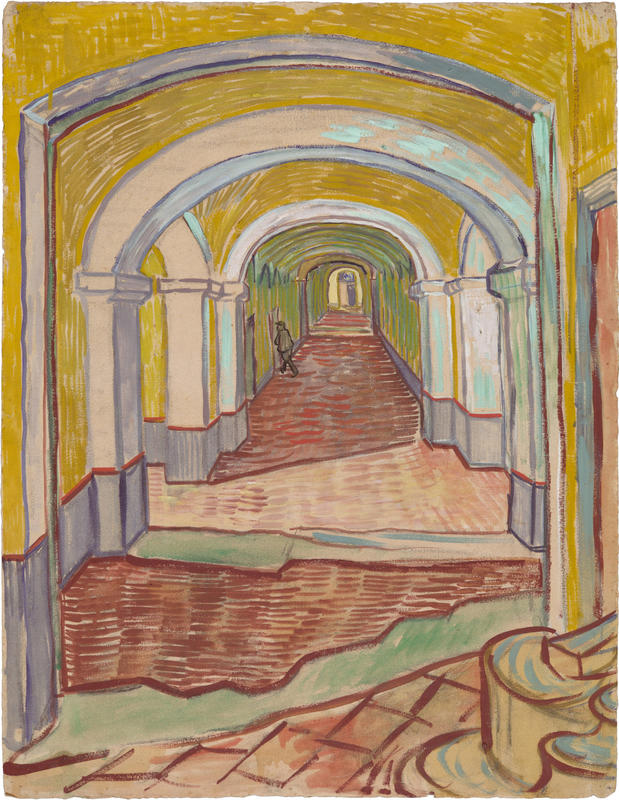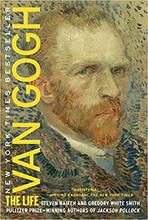More about Corridor in the Asylum
- All
- Info
- Shop

Contributor
Corridor in the Asylum is one of the premier interpretations of what Van Gogh’s hectic stay at Saint-Paul-de-Mausole looked like.
It was drawn as a reference for his brother, Theo, to give him a glimpse of his everyday life. Though the subject matter of the drawing paints a clear picture of his mundane reality, it doesn’t quite feel as haunted as Van Gogh probably felt being there. It features his signature swirly brush strokes with colors that feel more inviting than they do threatening. Van Gogh was more than likely giving an objective view, but it’s the act of Corridor’s creation at all that speaks volumes to his mental and emotional state at the time.
Vincent moved a lot. 37 times in his 37 years to be exact. He could never find a place that satisfied him enough to stay. Two of his more productive stops happened to be back to back, and they contrast with each other like chocolate and tuna. In 1888, he moved into the famed Yellow House in Arles, France with fellow artist Paul Gauguin. They’d hoped to provide a space where a collective of artists could thrive and bounce off of each other creatively. While in Arles, Van Gogh produced a lot of work, the most famous of which might be his painting Bedroom, a self-portrait of sorts that shows the intimate space the artist inhabited, as opposed to his actual face. After just over a year at the Yellow House, Van Gogh suffered his mental break and checked into the Saint-Paul asylum where he’d spend twelve more months. And as you could imagine, his time there wasn’t super fulfilling. Yet he still flourished creatively. If you can look at Bedroom as a self-portrait, then you can also look at Corridor in the Asylum as one. Their differences are stark. One is full. The other, empty. While Bedroom features little Easter eggs that all point to a complete version of Van Gogh, Corridor is an empty hallway that feels like it could go on forever. Whether this was intended or not, it’s a powerful metaphor for what he might have been feeling.
Things at the asylum got so bad a handful of times that the director of the facility sent word to Van Gogh’s brother that “[o]n several occasions he has attempted to poison himself, either by swallowing colours that he used for painting, or by ingesting paraffin, which he had taken from the boy while he was filling his lamps.” Vincent’s free will was stripped away, and there weren’t many options for him.
And while that was a bad thing for his mental health, it was a good thing for his creativity. Although he whiled away many hours copying works of other artists from prints and books, much of the art he created in the asylum always seemed to be predicated on his limited views of the world from the inside. He painted or drew when he got fresh air, when he could catch a glimpse of normal life through the window of his cell, or when he chilled in the gardens of the asylum. His creativity was sparked by its constant neglect, so when he was able to do what he loved, it was always reflected on the canvas. Nothing that he produced during this time, even Corridor in the Asylum, feels as bleak as it undoubtedly should.
Sources
- Johnson, Steve. 'Van Gogh's Bedrooms' at Art Institute Show Artist's Quest For Home.” Chicago Tribune. February 10, 2016. https://www.chicagotribune.com/entertainment/museums/ct-ent-0204-van-go…
- Kennedy, Maev. “Van Gogh’s ‘Terrifying Environment’ of French Asylum Revealed.” The Guardian. August 25, 2018. https://www.theguardian.com/artanddesign/2018/aug/25/vincent-van-gogh-d…

















I like Vincent's painting because he always uses simple colors to present what he thinks. Such as this one, its colors are pretty simple, not fancy at all, but the whole structure is pretty good, and build a vision of space for audiences.